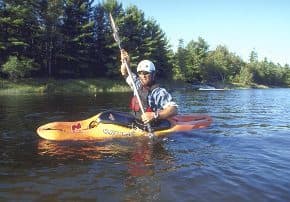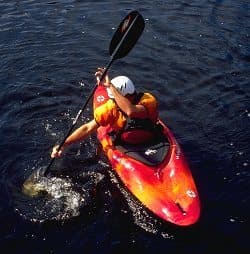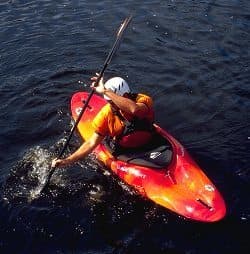Draw Strokes - Whitewater
Draws are dynamic strokes that either pull water towards or push water away from the side of the boat at any point along its length for a variety of effects. That's a mouthful! They do not propel the boat forward or backward, but are often used while moving or in combination with other strokes. Draws can serve as a keel to keep the boat on its track, as a rudder to steer a moving boat temporarily, as a powerful pivoting stroke, and for many other useful functions. Becoming proficient with all types of draws is a significant and vital part of your learning process.
The first things to get comfortable with are the basic positions for draws, the lateral forces involved, and the art of feathering your blade. You can begin by using a draw while stationary to shuffle the boat sideways. This can be achieved with a T-stroke draw or a sculling draw.
T-Stroke
For the T-stroke, start by rotating your upper body at the hips towards the side that your draw stroke will be on (pick either one). Looking in the same direction, plant your blade out beside you approximately a foot or two away from the boat with the power face towards you. Position the paddle as vertically as possible. The more you can twist at the hips, the easier this will be to achieve. The boat should remain flat to avoid catching an edge. With the blade completely under water, pull with your lower hand in towards the boat. This should make the boat shift sideways towards the blade.


Before the paddle hits the boat, stop pulling and curl your wrist forward ninety degrees, until you can slice (or "feather") the blade back to its starting position. Repeat this several times until you can move the boat sideways in both directions. To move directly sideways, your draw must be centered and the path of your stroke should be forming a "T" with the boat. If it's not, you'll find yourself pulling either the bow or stern around in a circle (strokes that we'll look at below).
Sculling
The sculling draw is set up in the same way as the T-stroke. However, once you're wound up and the blade is planted out to the side, practise opening and closing your power face. To open the power face is to expose more of it to the bow; to close it is to expose more of it to the stern. This requires you to rotate your wrists forward and backward with the blade in the water, which you'll become more proficient at with time. To scull, start with the blade on the surface and feather it back and forth between a slight open face and a slight closed face while working on a path about the length of your cockpit. To maintain a climbing angle on your blade (which allows you to apply pressure on the blade without its sinking or pulling it into the kayak), the leading edge of the blade needs to be raised.


This means opening the power face while pushing to the bow and closing it while sliding it to the stern. Think about buttering toast with only the power face of your paddle. As you're doing this, put more of the blade under water and pull in lightly toward you to start moving the boat sideways. Try to keep the blade at least a foot or two away from the boat by balancing how much you open or close the face with how hard you pull. The most effective draw has your paddle in an almost vertical position. To do this, you'll need to develop the balance to reach comfortably across your kayak with your top hand. Again, get comfortable with this on both sides--it can come in handy for manoeuvring the boat and is excellent practise for paddle dexterity.
Ken Whiting was the 1997/98 World Whitewater Freestyle Champion. He has produced an award-winning series of instructional kayaking books and DVDs, and leads kayaking trips to Chile. Look for his new book 'The Ultimate Guide to Whitewater Kayaking', and video 'The Ultimate Guide to Sea Kayaking'. Check out www.helipress.com
Related Articles
Kayak Hipster demonstrates 3 things to try next time you're working on your sculling draw. An efficient…
If you're new to paddle boarding, in 5 minutes you can get the tips you need to get out on the water…
One of the great things about stand-up paddle boarding is that it can be a remarkably safe and…
There are times when we need and want a reliable continuous brace. For a brace to be continuous it needs…



